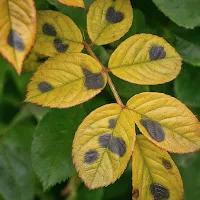Understanding and addressing plant diseases is crucial for maintaining a healthy garden.
Common Plant Diseases
Leaf Spots
- Black Spot: Primarily affects roses.
Causes black spots on leaves, leading to yellowing and premature drop. - Treatment: Proper spacing, avoiding overhead watering, removing infected leaves, and using fungicides can help.
- Other Leaf Spots: Can be caused by various pathogens. Symptoms vary, but often include spots, holes, or discoloration.
- Treatment: Good sanitation, proper watering, and fungicide applications can be effective.
- White powdery coating on leaves, stems, and flowers.
- Treatment: Improve air circulation, avoid overhead watering, and use fungicides.
Neem oil can be an organic option.
Downy Mildew
- Similar to powdery mildew but often causes yellowing on the upper leaf surface and purple or gray fuzzy growth on the underside.
- Treatment: Similar to powdery mildew, but copper-based fungicides are often more effective.
- Rapidly spreading disease causing leaf spots, cankers, and dieback.
- Treatment: Proper sanitation, pruning infected parts, and using fungicides can help.
Canker
- Sunken, dead areas on stems or branches.
- Treatment: Pruning infected parts, proper sanitation, and avoiding wounds are essential.
- Good Sanitation: Remove and destroy infected plant parts to prevent disease spread.
- Proper Watering: Avoid overhead watering, as wet leaves promote fungal growth.
- Adequate Air Circulation: Space plants properly to allow good airflow.
- Resistant Varieties: Choose plant varieties known for disease resistance.
- Crop Rotation: Rotate crops to reduce disease buildup in the soil.
- Fungicides: Use fungicides as a last resort and according to label instructions.
Role of Tricoderma viride, Pseudomonas fluorescens, and Neem Oil Cake in Plant Disease Prevention
These three natural agents are potent allies in the battle against plant diseases. Let's delve into how they work:
Tricoderma viride
A beneficial fungus, Tricoderma viride, is a biological control agent that helps to protect plants from a wide range of pathogens.
- Mechanism of action:
- Competes with harmful fungi for nutrients and space.
- Produces enzymes that break down the cell walls of harmful fungi.
- Induces systemic resistance in plants, making them more resilient to diseases.
Pseudomonas fluorescens
Another beneficial bacterium, Pseudomonas fluorescens, is renowned for its disease-suppressing properties.
- Mechanism of action:
- Produces antibiotics that inhibit the growth of harmful bacteria and fungi.
- Promotes plant growth and development.
- Enhances nutrient uptake by plants.
Neem Oil Cake
A natural byproduct of neem oil extraction, neem oil cake is rich in organic matter and possesses antifungal and insecticidal properties.
- Mechanism of action:
- Enhances soil fertility and structure.
- Repels pests and nematodes.
- Acts as a slow-release nitrogen source.
- Contains compounds with antifungal properties.
How They Prevent Plant Diseases
These three agents work synergistically to create a hostile environment for pathogens.
- Tricoderma viride colonizes the root zone, protecting it from soil-borne pathogens.
- Pseudomonas fluorescens also inhabits the root zone, providing additional protection against bacteria and fungi.
- Neem oil cake enriches the soil, improving plant health and making them more resistant to diseases.
Combined application of these agents can significantly reduce the incidence of plant diseases, leading to healthier and more productive plants.
Important Considerations
- Organic farming: These agents are ideal for organic farming practices as they are environmentally friendly.
- Soil health: Consistent use of these products can improve soil health over time.
- Application timing: For optimal results, apply these agents at the time of planting or as a preventive measure.
- Integration with other practices: Combine these biological agents with good cultural practices like crop rotation, sanitation, and proper watering for comprehensive disease management.
By understanding the roles of Tricoderma viride, Pseudomonas fluorescens, and neem oil cake, you can effectively protect your plants from a variety of diseases and promote sustainable agriculture.





.jfif)

.jfif)


Comments
Post a Comment